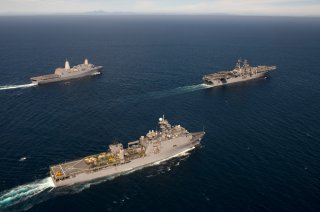Everything You Need To Know About the Marine Corps’ New Warship
Like the famous Higgins boats during World War II, the new Light Amphibious Warship will form the backbone of the Marine’s updated Pacific strategy.
The ships will likely be based out of Hawaii, and they’ll pose a serious threat to Chinese ships.
Like the Higgins boats that were central to the Marine Corps’ Second World War-era island-hopping campaign, the new Light Amphibious Warship will form the backbone of the Marine’s newer, more updated Pacific maritime strategy.
The Marine Corps’ new class of vessels will likely be based out of Hawaii. The new ships are estimated to cost $100 million to $130 million apiece, a price tag that is much lower than other new naval ships, the Honolulu-based Star Advertiser reported.
Though the ultimate Light Amphibious Warship design has yet to be finalized concretely, tentative artwork from the Congressional Research Service and elsewhere indicates a length between 200 to 400 feet in length with a single, centrally locked helipad and sufficient onboard space to house and transport 40 sailors and 75 or more Marines. The ships would also need sufficient space for 4,000 to 8,000 square feet of cargo space to hold food, vehicles, and ammunition, and a range of about 4,000 miles, or nearly 6,500 kilometers—almost the distance from Hawaii to Japan.
Unlike the much smaller Higgins boats or other larger Marine landing craft, the Light Amphibious Warship would be stern-loading, facilitating offloading from a ramp at the rear rather than the front. This design choice would allow the ship to retain a pointed bow, rather than a flat, sloped front like the Higgins and allow for a more streamlined design and therefore a higher top speed and greater range.
The news ships are expected to work in tandem with the Marine Corps’ new Marine Littoral Regiment (MLR), a new force of about 2,200 Marines organized into three differing but complementary groups: a logistics element, an anti-aircraft element, and a combat element. Given that the Marine Corps would like 28 to 30 Light Amphibious Warships, it is possible that the MLRs would be split up further and distributed among the vessels.
This would be in line with the Marine Corps’ radial new force design which would see smaller groups of Marines spread out throughout the Pacific, decentralized in terms of physical placement as well as command. Prowling the high seas, these Marines would flit to and fro, from one of the many islands that dot the world’s largest ocean to the next.
High mobility and decentralized decision-making play well to the Corps’ tradition of pushing decision-making downwards, emphasizing greater responsibility and tactical flexibility at the squad level than in other branches. Coupled with a number of new and radically different ideas, like autonomous ship-killing trucks and Air Force-Marine cooperation in seizing enemy-held islands, the Marine Corps is undergoing rapid and radical change.
The Corps’ new Light Amphibious Warship will likely make waves, both literal and figurative once introduced and in widespread service. And once they are, the Marines will be able to threaten wide swaths of the Pacific—near peers beware.
Caleb Larson is a defense writer for the National Interest. He holds a Master of Public Policy and covers U.S. and Russian security, European defense issues, and German politics and culture.
Image: Wikimedia Commons.

